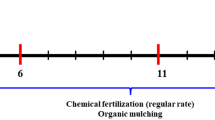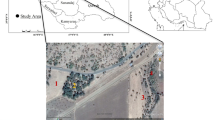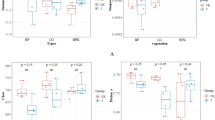Abstract
In forest ecosystems, landslides are one of the most common natural disturbances, altering the physical, chemical and microbial characteristics of soil and thus further altering ecosystem properties and processes. Although secondary forests comprise more than 50% of global forests, the influence of landslides on the soil properties in these forests is underappreciated. Therefore, this study investigates the influence of landslides on the chemical and microbial nature of the soil. Study of these modifications is critical, as it provides baseline evidence for subsequent forest revegetation. We selected four independent landslides and adjacent secondary forest stands as references in a temperate secondary forest in northeastern China. Soils were obtained from each stand at 0–10 cm and 10–20 cm depths to determine chemical and microbial properties. Soil total carbon (TC), total nitrogen (TN), nitrate (NO3−-N), available phosphorus (P), microbial biomass carbon (MBC), microbial biomass nitrogen (MBN), microbial biomass phosphorus (MBP) and phenol oxidase, exoglucanase, β-glucosidase, N-acetyl-β-glucosaminidase, L-asparaginase and acid phosphatase activities were 29.3–70.1% lower at the 0–10 cm soil depth in the landslide sites than at the secondary forest sites, whereas total phosphorus (TP) and ammonium (NH4+-N) were unaffected by the landslides. N-related enzymes, N-acetyl-β-glucosaminidase and L-asparaginase were reduced by more than 65% in the landslide sites, consistent with the decrease in nitrate concentration at the same 0–10 cm depth. At a depth of 10–20 cm, the variations in the soil properties were consistent with those at the 0–10 cm depth. The results demonstrated that soil chemical and microbial properties were significantly disrupted after the landslides, even though the landslides had occurred 6 years earlier. A long time is thus needed to restore the original C and nutrient levels. In temperate secondary forests, soil TC and TN contents were found to be more suitable for estimating the state of soil restoration than soil TP content.





Similar content being viewed by others
References
Balzano B, Tarantino A, Ridley A (2019) Preliminary analysis on the impacts of the rhizosphere on occurrence of rainfall-induced shallow landslides. Landslides 16:1885–1901
Begum F, Ali K, Khan MZ, Ishaq S, Ali H, Ahmed S, Mumtaz S (2018) Effect of landslide-induced flood on soil physicochemical properties in the mountainous landscape, northern Pskistan. Fresen Environ Bull 27:8128–8132
Błońska E, Lasota J, Piaszczyk W, Wiecheć M, Klamerus-Iwan A (2017) The effect of landslide on soil organic carbon stock and biochemical properties of soil. J Soil Sediment 18(8):2727–2737
Błońska E, Lasota J, Zwydak M, Klamerus-Iwan A, Gołąb J (2016) Restoration of forest soil and vegetation 15 years after landslides in a lower zone of mountains in temperate climates. Ecol Eng 97:503–515
Bostrom B, Comstedt D, Ekblad A (2007) Isotope fractionation and 13C enrichment in soil profiles during the decomposition of soil organic matter. Oecologia 153:89–98
Brookes PC, Landman A, Pruden G, Jenkinson DS (1985) Chloroform fumigation and the release of soil-nitrogen: a rapid direct extraction method to measure microbial biomass nitrogen in soil. Soil Biol Biochem 17(6):837–842
Brookes PC, Powlson DS, Jenkinson DS (1982) Measurement of microbial biomass phosphorus in soil. Soil Biol Biochem 14:319–329
Burns RG, Dick RP (2002) Enzymes in the environment: activity, ecology and applications. Enzyme Activities and Microbiological and Biochemical Processes in Soil. Marcel Dekker, New York, pp 1–38
Cai XQ, Lin ZW, Penttinen P, Li YF, Li YC, Luo Y, Yue T, Jiang PK, Fu WJ (2018) Effects of conversion from a natural evergreen broadleaf forest to a Moso bamboo plantation on the soil nutrient pools, microbial biomass and enzyme activities in a subtropical area. For Ecol Manag 422:161–171
Chen DD, Zhang SH, Dong SK, Wang XT, Du GZ (2010) Effect of land-use on soil nutrients and microbial biomass of an alpine region on the northeastern Tibetan plateau, China. Land Degrad Dev 21:446–452
Chen HYH, Brant AN, Seedre M, Brassard BW, Taylor AR (2017) The contribution of litterfall to net primary production during secondary succession in the boreal forest. Ecosystems 20:830–844
Cheng CH, Hsiao SC, Huang YS, Hung CY, Pai CW, Chen CP, Menyailo OV (2016) Landslide-induced changes of soil physicochemical properties in Xitou, central Taiwan. Geoderma 265:187–195
Cohen WB, Yang Z, Stehman SV, Schroeder TA, Bell DM, Masek JG, Huang C, Meigs GW (2016) Forest disturbance across the conterminous united states from 1985 to 2012: the emerging dominance of forest decline. For Ecol Manag 360:242–252
Cotrufo MF, Soong JL, Horton AJ, Campbell EE, Haddix Michelle L, Wall DH, Parton WJ (2015) Formation of soil organic matter via biochemical and physical pathways of litter mass loss. Nat Geo 8:776–779
Crow SE, Lajtha K, Filley TR, Swanston CW, Bowden RD, Caldwell BA (2009) Sources of plant-derived carbon and stability of organic matter in soil: Implications for global change. Glob Change Biol 15:2003–2019
Deng Q, Cheng X, Hui D, Zhang Q, Li M, Zhang Q (2016) Soil microbial community and its interaction with soil carbon and nitrogen dynamics following afforestation in central China. Sci Total Environ 541:230–237
Feng X (2002) A theoretical analysis of carbon isotope evolution of decomposing plant litters and soil organic matter. Glob Biogeochem Cycle. https://doi.org/10.1029/2002GB001867
Fierer N, Strickland MS, Liptzin D, Bradford MA, Cleveland CC (2009) Global patterns in belowground communities. Ecol Lett 12:1238–1249
Frankenberger WT, Tabatabai MA (1991) L-asparaginase activity of soils. Biol Ferti Soils 11:6–12
Frizano J, Johnson AH, Vann DR, Scatena FN (2002) Soil phosphorus fractionation during forest development on landslide scars in the Luquillo mountains, Puerto-Rico. Biotropica 34:17–26
Gonzalez-Ollauri A, Mickovski SB (2017) Shallow landslides as drivers for slope ecosystem evolution and biophysical diversity. Landslides 14:1699–1714
Haering V, Fischer H, Cadisch G, Stahr K (2013) Improved delta C-13 method to assess soil organic carbon dynamics on sites affected by soil erosion. Eur J Soil Sci 64:639–650
Lemanowicz J (2018) Dynamics of phosphorus content and the activity of phosphatase in forest soil in the sustained nitrogen compounds emissions zone. Environ Sci Pollut Res Int 25:33773–33782
Li B, Zeng T, Ran JH, Yue BS, Zhang M, Shang T, Zhu DH (2017a) Characteristics of the early secondary succession after landslides in a broad-leaved deciduous forest in the south Minshan mountains. For Ecol Manag 405:238–245
Li XF, Jin L, Zhang JJ, Liu LL, Zhang JX, Wang Y, Zhu CY (2017b) Response of species and stand types to snow/wind damage in a temperate secondary forest, northeast China. J for Res 29:395–404
Llorente M, Glaser B, Turrión MB (2010) Anthropogenic disturbance of natural forest vegetation on calcareous soils alters soil organic matter composition and natural abundance of 13C and 15N in density fractions. Eur J for Res 129:1143–1153
Masyagina OV, Evgrafova SY, Bugaenko TN, Kholodilova VV, Krivobokov LV, Korets MA, Wagner D (2019) Permafrost landslides promote soil CO2 emission and hinder c accumulation. Sci Total Environ 657:351–364
Medorio-García HP, Alarcón E, Flores-Esteves N, Montaño NM, Perroni Y (2020) Soil carbon, nitrogen and phosphorus dynamics in sugarcane plantations converted from tropical dry forest. Appl Soil Ecol. https://doi.org/10.1016/j.apsoil.2020.103600
Olsen SR, Sommers LE (1982) Phosphorus. In: Page AL and Miller RH, Eds. (eds) Methods of soil analysis part 2 chemical and microbiological methods, ASA and SSSA, Madison
Parham JA, Deng SP (2000) Detection, quantification and characterization of beta-glucosaminidase activity in soil. Soil Biol Biochem 32:1183–1190
Reddy VS, Singh JS (1993) Changes in vegetation and soil during succession following landslide disturbance in the central Himalaya. J Environ Manage 39:235–250
Saiya-Cork KR, Sinsabaugh RL, Zak DR (2002) The effects of long term nitrogen deposition on extracellular enzyme activity in an acer saccharum forest soil. Soil Biol Biochem 34:1309–1315
Schomakers J, Jien SH, Lee TY, Huang JC, Hseu ZY, Lin ZL, Lee LC, Hein T, Mentler A, Zehetner F (2019) Soil and biomass carbon re-accumulation after landslide disturbances. Geomorphology (amst) 288:164–174
Shi W, Dell E, Bowman D, Iyyemperumal K (2006) Soil enzyme activities and organic matter composition in a turfgrass chronosequence. Plant Soil 288:285–296
Shiels AB, Walker LR, Thompson DB (2005) Organic matter inputs create variable resource patches on Puerto Rican landslides. Plant Ecol 184:223–236
Singh KP, Mandal TN, Tripathi SK (2001) Patterns of restoration of soil physicochemical properties and microbial biomass in different landslide sites in the sal forest ecosystem of Nepal Himalaya. Ecol Eng 17:385–401
Sinsabaugh RL, Hill BH, Shah JJF (2009) Ecoenzymatic stoichiometry of microbial organic nutrient acquisition in soil and sediment. Nature 462:795–798
Sinsabaugh RL (2010) Phenol oxidase, peroxidase and organic matter dynamics of soil. Soil Biol Biochem 42:391–404
Sinsabaugh RL, Lauber CL, Weintraub MN, Ahmed B, Allison SD, Crenshaw C, Contosta AR, Cusack D, Frey S, Gallo ME, Gartner TB, Hobbie SE, Holland K, Keeler BL, Powers JS, Stursova M, Takacs-Vesbach C, Waldrop MP, Wallenstein MD, Zak DR, Zeglin LH (2008) Stoichiometry of soil enzyme activity at global scale. Ecol Lett 11:1252–1264
Sparling GP (1992) Ratio of microbial biomass carbon to soil organic carbon as a sensitive indicator of changes in soil organic matter. Aust J Soil Res 30:195–207
Tabatabai MA (1994) Soil enzymes. In: Weaver RW, Angle Scott, Bottomley Peter, Bezdicek David, Smith Scott, Tabatabai Ali, Wollum Art (eds) Methods of Soil Analysis: Part 2 Microbiological and Biochemical Properties. Soil Science Society of America, Madison. https://doi.org/10.2136/sssabookser5.2.c37
Taki H, Makihara H, Matsumura T, Hasegawa M, Matsuura T, Tanaka H, Si M, Okabe K (2013) Evaluation of secondary forests as alternative habitats to primary forests for flower-visiting insects. J Insect Conserv 17:549–556
Tian H, Chen G, Zhang C, Melillo JM, Hall CAS (2009) Pattern and variation of C:N: P ratios in China’s soils: a synthesis of observational data. Biogeochemistry 98:139–151
Turner BL, Hopkins DW, Haygarth PM, Ostle N (2002) Beta-glucosidase activity in pasture soils. Appl Soil Ecol 20:157–162
Ullah R, Lone MI, Ullah KS, Mehdi SM, Qazi MA (2013) Effect of cropping system and seasonal variation on soil microbial biomass and enzymatic activities in arid soils. J Anim Plant Sci-Pak 23:493–499
Van Eynde E, Dondeyne S, Isabirye M, Deckers J, Poesen J (2017) Impact of landslides on soil characteristics: implications for estimating their age. CATENA 157:173–179
Vance ED, Brookes PC, Jenkinson DS (1987) An extraction method for measuring soil microbial biomass c. Soil Biol Biochem 19:703–707
Von Mersi W, Schinner F (1996) Dehydrogenase activity with the substrate int. In: Schinner F, Õhlinger R, Kandeler E and Margesin Re (eds) Methods in soil biology, Springer, Berlin, pp 243–245
Walker LR, Shiels AB, Bellingham PJ, Sparrow AD, Fetcher N, Landau FH, Lodge DJ (2013) Changes in abiotic influences on seed plants and ferns during 18 years of primary succession on Puerto Rican landslides. J Ecol 101:650–661
Walker LR, Zarin DJ, Fetcher N, Myster RW, Johnson AH (1996) Ecosystem development and plant succession on landslides in the Caribbean. Biotropica 28:566–576
Wang WJ, Qiu L, Zu YG, Su DX, An J, Wang HY, Zheng GY, Sun W, Chen XQ (2011) Changes in soil organic carbon, nitrogen, pH and bulk density with the development of larch (Larix gmelinii) plantations in China. Glob Chang Biol 17:2657–2676
Wardle DA (1992) A comparative-assessment of factors which influence microbial biomass carbon and nitrogen levels in soil. Biol Rev 67:321–358
Wilcke W, Valladarez H, Stoyan R, Yasin S, Valarezo C, Zech W (2003) Soil properties on a chronosequence of landslides in montane rain forest, Ecuador. CATENA 53:79–95
Wu J, Joergensen RG, Pommerening B, Chaussod R, Brookes PC (1990) Measurement of soil microbial biomass C by fumigation extraction: an automated procedure. Soil Biol Biochem 22:1167–1169
Xu X, Inubushi K, Sakamoto K (2006) Effect of vegetations and temperature on microbial biomass carbon and metabolic quotients of temperate volcanic forest soils. Geoderma 136:310–319
Yang H, Yang T, Zhang S, Zhao F, Hu K, Jiang Y (2020) Rainfall-induced landslides and debris flows in Mengdong town, Yunnan province, China. Landslides 17:931–941
Yang K, Shi W, Zhu JJ (2012a) The impact of secondary forests conversion into larch plantations on soil chemical and microbiological properties. Plant Soil 368:535–546
Yang K, Zhu JJ, Yan QL, Sun OJ (2010a) Changes in soil p chemistry as affected by conversion of natural secondary forests to larch plantations. For Ecol Manage 260:422–428
Yang K, Zhu JJ, Yan QL, Zhang J (2012b) Soil enzyme activities as potential indicators of soluble organic nitrogen pools in forest ecosystems of northeast China. Ann for Sci 69:795–803
Yang K, Zhu JJ, Zhang M, Yan QL, Sun OJ (2010b) Soil microbial biomass carbon and nitrogen in forest ecosystems of northeast China: a comparison between natural secondary forest and larch plantation. J Plant Ecol 3:175–182
Zhong W, Gu T, Wang W, Zhang B, Lin X, Huang Q, Shen W (2009) The effects of mineral fertilizer and organic manure on soil microbial community and diversity. Plant Soil 326:511–522
Zhu JJ, Liu S (2007) Conception of secondary forest and its relation to ecological disturbance degree. Chin J Ecol 26:1085–1093
Zhu JJ, Mao Z, Hu L, Zhang J (2007) Plant diversity of secondary forests in response to anthropogenic disturbance levels in montane regions of northeastern China. J for Res 12:403–416
Acknowledgements
We are grateful to Mrs. Fengqin Li for assistance with experimental design.
Author information
Authors and Affiliations
Corresponding author
Additional information
Publisher's Note
Springer Nature remains neutral with regard to jurisdictional claims in published maps and institutional affiliations.
Project Funding: The work was supported by The National Natural Science Foundation of China (31922059) and the Key Research Program of Frontier Sciences, CAS (QYZDJ SSW DQC027 and ZDBS LY DQC019).
The online version is available at http://www.springerlink.com.
Corresponding editor: Yanbo Hu.
Rights and permissions
About this article
Cite this article
Zhang, Y., Miao, C., Zhu, J. et al. The impact of landslides on chemical and microbial properties of soil in a temperate secondary forest ecosystem. J. For. Res. 33, 1913–1923 (2022). https://doi.org/10.1007/s11676-022-01466-5
Received:
Accepted:
Published:
Issue Date:
DOI: https://doi.org/10.1007/s11676-022-01466-5




